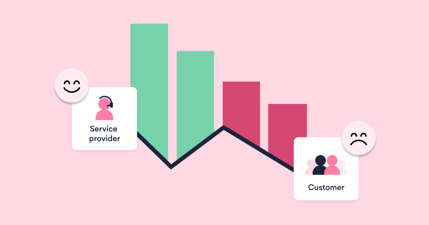In case you missed it, HappySignals celebrated its tenth birthday last year. It has been a journey we’ve shared with our customers as we’ve collectively refined what makes IT experience management (ITXM) successful in IT organizations and other business functions.
The IT industry’s interest and investments in experience management continue to grow, as does the employee experience or digital employee experience (DEX) landscape. But, as with anything in IT (or any other business function), looking at a particular IT or IT service management (ITSM) trend or capability in isolation is potentially dangerous. IT (or business) operations are more complex than simply “pulling on one lever” to drive operational and outcome improvements.
It’s with this perspective that I read ITSM.tools’ recent article on the key ITSM trends for 2025. This blog digs a little into what this survey says about IT service delivery and support’s direction before looking at what’s needed to elevate employee experience in your organization.
What IT professionals are interested in as we enter 2025
The top five “areas of interest” in the Trends for 2025 poll (where ITSM.tools readers want content-based help) were:
- Governance (including AI governance) (37%)
- Generative AI (GenAI) (35%)
- ITIL/ITSM “advanced” capabilities (31%)
- Value demonstration (28%)
- People (including attitude, behavior, and culture (ABC)) (27%).
If you’re wondering why the percentages add up to more than 100%, the 176 poll respondents were allowed to choose five options from 25 (plus an Other option).
Two options just missed out on the top five – digital employee experience management (DEX)/employee experience management and enterprise service management were in joint sixth place at 26%.
Where will IT professionals invest in 2025?
I think we all know the answer to this – GenAI. It offers a wealth of opportunities for your IT organization to improve its IT service delivery and support across all three of “better, faster, and cheaper.”
In particular, the addition of GenAI capabilities to ITSM tools will likely be “catnip” for IT professionals in ITSM roles. Ideally, they’ll also invest sufficiently in related governance capabilities. However, for me, this top option isn’t as much of a “sure thing.”
There’s a key question that needs to be asked here, though: “Which of the many possible GenAI-enabled capabilities will deliver the greatest business value?” These GenAI capabilities should be adopted in a prioritized manner, and some might not even be needed (because they offer insufficient business value or even kill business value).
However, let’s park this need for a moment and look at the three non-AI 2025 trends first: ITIL/ITSM “advanced” capabilities, value demonstration, and people (including attitude, behavior, and culture (ABC)).
I believe these three ITSM trends will likely see insufficient investment in 2025 in many IT organizations. Even though the addition of GenAI capabilities should be value-focused and the adoption of ITIL/ITSM “advanced” capabilities and improved people management could both be facilitated by GenAI.
There’s also a variant of the earlier question to consider: “Which of these ITSM trends will deliver the greatest business value?” In my experience, many IT organizations don’t know the answer because they have insufficient insight into how what they do and the outcomes they achieve create (or co-create) value for their parent organizations. This has to be one of the most important questions, if not the most important question, asked about your IT organization’s 2025 investment strategy.
I’ll put my soapbox away for a moment now to return to this blog’s title.
Elevating employee experience in your organization
You might not have noticed this yet, but the phrase “elevating employee experience in your organization” has two possible meanings:
- The need to focus more on the importance of employee experience to IT’s success in your organization
- Actually making data-informed changes to improve the delivered employee experience in your organization.
Either one or both of these meanings (or needs) could be relevant to you.
However, this blog is focused on the first of these – the need to understand and take action on the benefits of experience data, especially in deciding on what to improve and where.
To quote my recent post on LinkedIn:
“People ask me, ‘What’s the biggest change HappySignals can bring?’ I find myself answering this question daily — so why not share it here as well?
- Stop relying solely on process or technical metrics to measure IT success.
- Start measuring the value you create for your IT users by asking them directly.
By doing this, HappySignals helps uncover the blind spots in traditional IT metrics and reveals the problems worth solving.
IT experience isn’t just about metrics; it’s about understanding employee experience to make better decisions. And when you ask, ‘What decisions?’ my answer is: all decisions that impact your IT users. It can be developing your services or applications or even selecting service partners or other vendors.”
While people might focus on the ability to deliver better experiences and make employees happier (and more productive), employee experience is about having the experience data necessary to make better decisions.
So, bringing this back to the ITSM trends identified in the ITSM.tools poll, your IT organization’s experience data will help guide its decisions on where best to invest in 2025. Whether this is investing time and effort in the right GenAI resources, adopting (or improving) the most needed ITIL/ITSM “advanced” capabilities, being better able to demonstrate business value, or improving people management.
To answer this blog’s title, “What will it take to elevate employee experience in your organization?” it’s better to consider what might happen if you don’t do it (and my soapbox reappears). The absence of experience data to inform your IT organization’s investment decisions might lead to better IT operations (thanks to the GenAI investments) but worse business outcomes because IT simply isn’t delivering what your business and its employees need.
To learn more about getting started with employee experience, take a look here.




